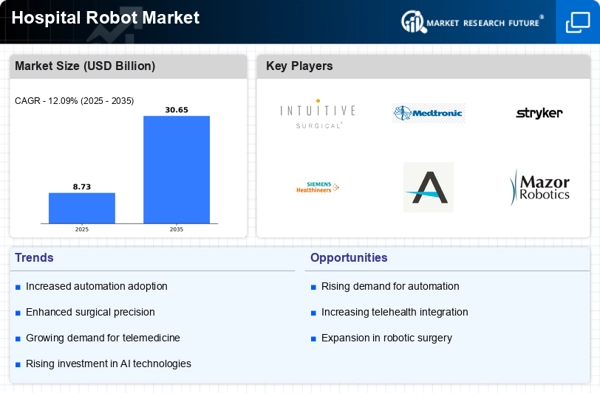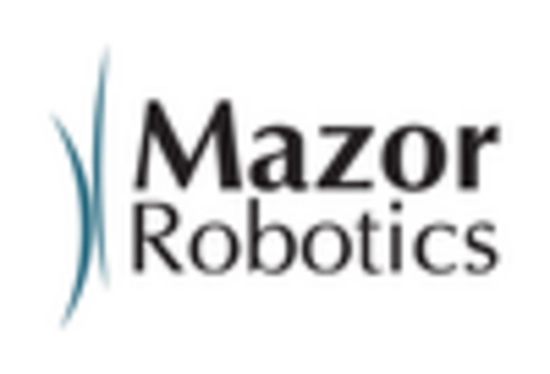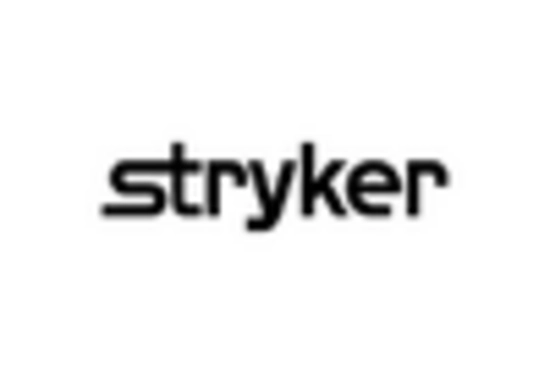Growing Focus on Patient-Centric Care
The Hospital Robot Market is increasingly aligned with the growing focus on patient-centric care. Healthcare providers are recognizing the importance of tailoring services to meet individual patient needs, and robotic systems are playing a pivotal role in this transformation. Robots designed for rehabilitation and assistance are enhancing the patient experience by providing personalized care and support. Market analysis indicates that the demand for rehabilitation robots is expected to rise significantly, with projections suggesting a market size of USD 5 billion by 2027. This shift towards patient-centric solutions underscores the evolving role of robotics in healthcare, highlighting the Hospital Robot Market's potential to improve patient satisfaction and outcomes.
Technological Advancements in Robotics
The Hospital Robot Market is experiencing a surge in technological advancements, particularly in robotic systems designed for surgical procedures. Innovations such as enhanced precision, improved imaging capabilities, and minimally invasive techniques are driving the adoption of surgical robots. According to recent data, the market for surgical robots is projected to reach USD 12 billion by 2026, indicating a robust growth trajectory. These advancements not only enhance surgical outcomes but also reduce recovery times for patients, thereby increasing the overall efficiency of healthcare delivery. As hospitals seek to improve patient care and operational efficiency, the integration of advanced robotic technologies becomes increasingly critical, positioning the Hospital Robot Market for sustained growth.
Rising Demand for Automation in Healthcare
The Hospital Robot Market is witnessing a rising demand for automation in healthcare settings. As healthcare providers strive to enhance operational efficiency and reduce human error, the implementation of robotic systems is becoming more prevalent. Automation in tasks such as medication dispensing, patient monitoring, and surgical assistance is not only streamlining workflows but also improving patient safety. Market data suggests that the automation segment within the hospital robotics sector is expected to grow at a compound annual growth rate of 15% over the next five years. This trend reflects a broader shift towards technology-driven solutions in healthcare, underscoring the importance of robotics in modern medical practices.
Aging Population and Increased Chronic Diseases
The Hospital Robot Market is significantly influenced by the aging population and the rising prevalence of chronic diseases. As the demographic landscape shifts, there is an increasing need for efficient healthcare solutions to manage complex medical conditions. Robotic systems are being deployed to assist in surgeries, rehabilitation, and patient monitoring, addressing the challenges posed by an aging populace. Data indicates that the number of surgical procedures performed using robotic assistance is expected to double in the next decade, driven by the need for precision and efficiency in treating chronic illnesses. This demographic trend is likely to propel the Hospital Robot Market forward, as healthcare systems adapt to meet the demands of an older population.
Increasing Investment in Healthcare Infrastructure
The Hospital Robot Market is benefiting from increasing investments in healthcare infrastructure across various regions. Governments and private entities are allocating substantial funds to upgrade medical facilities, which includes the acquisition of advanced robotic systems. This trend is particularly evident in emerging markets, where healthcare systems are rapidly evolving. For instance, investments in robotic surgery systems are projected to increase by 20% annually as hospitals aim to enhance their service offerings. Such investments not only facilitate the adoption of cutting-edge technologies but also contribute to improved patient outcomes, thereby reinforcing the significance of the Hospital Robot Market in the broader healthcare landscape.

















Leave a Comment